If you miss the taste of garlic in your meals, garlic-infused oil is an ideal replacement to evoke its garlic aroma without making your stomach growl.
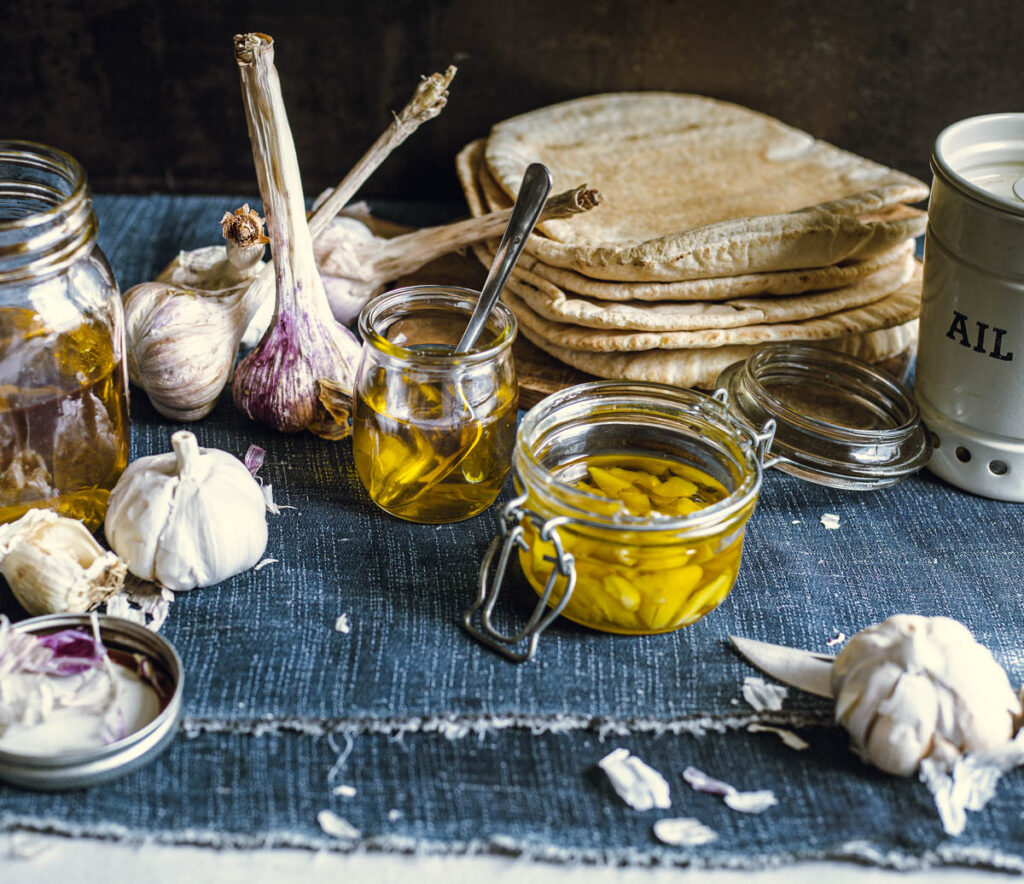
Jump to:
Why this Recipe is So Life-Changing
When I learned that I had to ban garlic from my diet—specifically, during my elimination phase of the low FODMAP diet—I have to admit, I was devastated, depressed by this dizzying news. This is because, for many, it's a major digestive disruptor, a main trigger of irritable bowel syndrome (IBS).
But condemning it is so… cruel! No garlic in my food? I must we send it to the dungeon? Oh! Garlic breath, you, who we're trying so quickly to erase, come back to me quickly now.
If one despises the cloves of this head covered with a beautiful parchment tunic, it's because it contains fructans. These are sugars that are difficult to digest or absorb in your intestines (the small and the large intestine). So, during this phase, you can't cook it in whatever form: crushed/mashed or powdered (yeah, good try).
But I have good news, dear friend, shaken by FODMAPs!
The incriminated fructans are not soluble in oil! So what? This means all that garlic flavor can be infused into the oil without any adverse effects! (Do you see my big smile coming out of your screen?)
You can recall without having to worry this flavor which raises and elevates all the others!
And you'll be delighted.
My garlic-infused oil is an absolute dream come true.
Although subtle, the garlic flavor is tasty, and a tangy sensation arises deep in your palate, secretive, stealthy, teasing, yet inviting.
This oil will change your life!
What Goes in it?
Concocting your own garlic-infused oil is very easy! Also, you only need two ingredients.
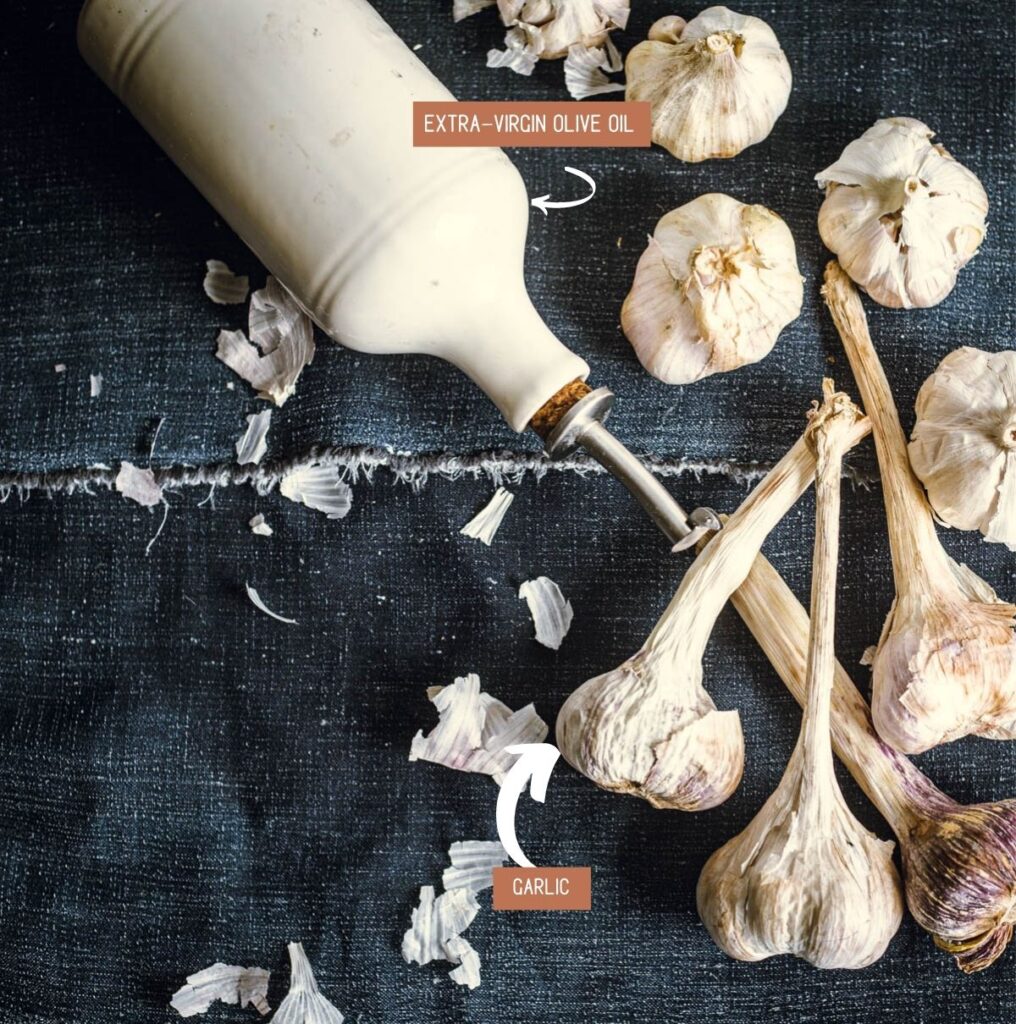
Ingredients Notes
- Extra-virgin olive oil. It provides both a light herbaceous flavor. You can replace it with sunflower oil, canola oil (rapeseed oil), rice bran oil, or else for a more neutral taste.
- Garlic. Choose fresh garlic.
Simple Substitutions and Add-ins
You can add other ingredients to make it more fancy.
1 / Hot-infused olive oil:
Decorate it with dry herbs, such as thyme and rosemary, or tasty and dried vegetables.
2 / Cold-infused olive oil:
Add other fresh herbs such as rosemary, cilantro, lemon zest (previously dried), etc.
How to Make low-FODMAP Garlic-Infused Oil Step By Step
① Crush the garlic or cut in big pieces.
② Heat the oil in a small saucepan over low heat until it's just hot to the touch, then remove from the heat.
③ Add the garlic to the hot (but not boiling) oil, away from the heat, and let stand for about 2 hours.
④ Strain the oil in a sterilized jar, taking care to remove all the pieces of garlic.
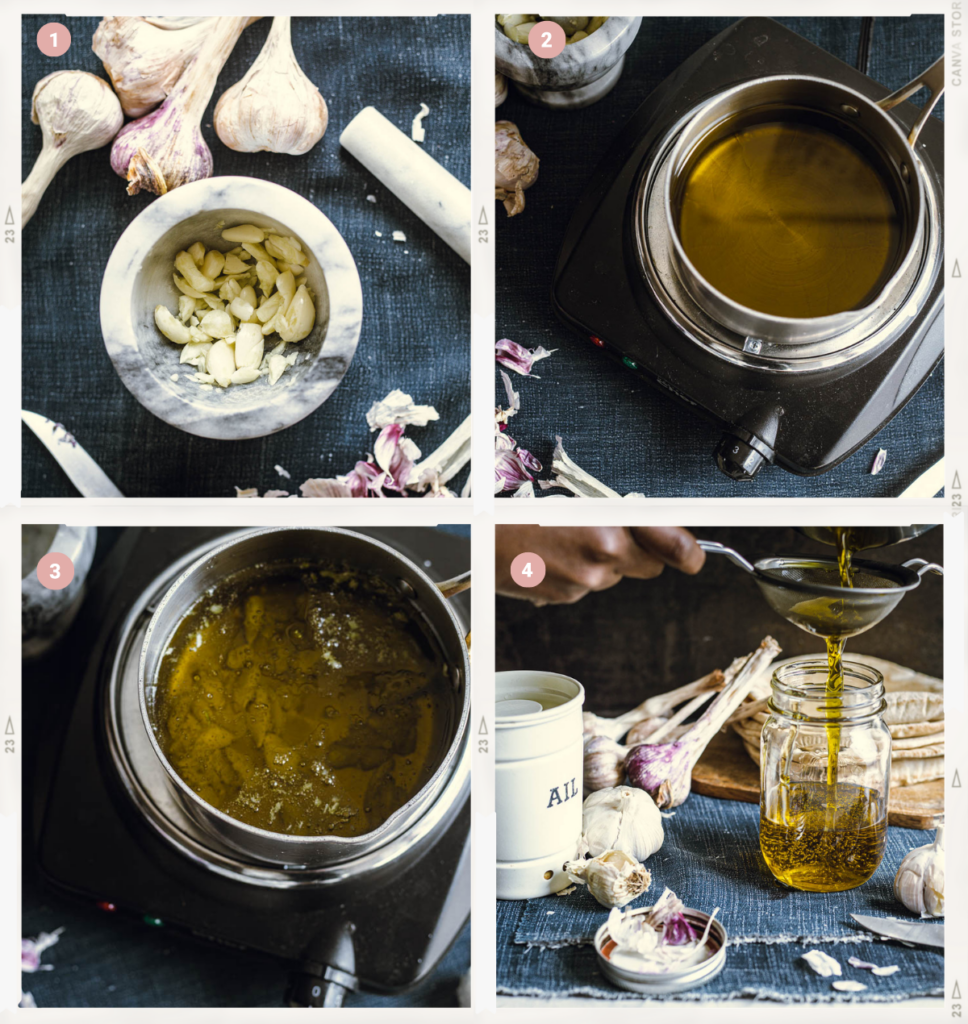
The Keys to Success: My Top Tips
Choose quality ingredients
First, make sure you're using the olive oil you'd like to eat with a spoon. From there, it's hard to go wrong.
Look for a production date, usually November, on the label when buying a bottle to make sure you buy a recent press. Usually, it will go rancid about 12 to 14 months after being pressed. Always choose one from the Mediterranean basin produced 100% from olives from the country indicated.
Beware of those whose labels simply state (usually in small print): "Bottled in ...". This implies that the oil is pressed from olives whose provenance cannot be traced or guaranteed.
Second, make sure you use a good-looking bulb of fresh garlic—there shouldn't be any green shoots rising upwards. And each pod should be smooth, firm, and not spongy in the slightest. Older garlic is likely to leave an unpleasant bitterness as an aftertaste.
Think about how you'll use the oil
You can use any type of oil you like. Here, the oil acts as a carrier.
If you plan to make Italian-inspired dishes, like pesto or other typical dishes, use olive oil as a base. If you don't want to perceive the flavor of the olive, choose a more subtle, neutral oil.
For example, use sunflower, grape seed, safflower, canola (rapeseed), rice bran, or another oil.
Modulate the intensity of the garlic
For a more subtle garlic flavor, leave the whole garlic cloves; for a more powerful garlic flavor, cut them in half or crush them coarsely with the back of a knife or in a mortar, for instance.
How to serve it
Your homemade low-FODMAP garlic-infused olive oil can act as a carrier or seasoning.
It's qualified as a carrier when you heat it to cook food and as a seasoning to adjust the flavor or enrich the texture of a dish just before serving.
The amount of garlic in the recipe below is for moderate flavor; neither too weak nor too bold. For recipes where the taste is prominent, such as in basil pesto, I recommend that you double the quantity.
Answers to your Burning Questions
It's an oil in which garlic has been macerated for some time to give it a garlic aroma. Sometimes oil is said to be infused with a garlic flavor, and it shows minced garlic. But for people who must follow a low-FODMAP diet, there must be no solids.
You would be amazed to know that it is. How is it possible?
FODMAPs are only soluble in water and not in oil.
In fact, if you put garlic cloves in your water-based concoctions, the fructans will escape from the garlic to seep into the ingredients of your dishes and inextricably intertwine with them, increasing the FODMAP content.
BUT if you fry the garlic in oil or infuse the oil with garlic, you'll get all the garlic flavor without any of the FODMAPs, which will get trapped in the garlic. Because, as I said earlier, fructans cannot escape in the oil fat (1).
This means that the garlic-infused oil contains all of that delicious garlic flavor while low in FODMAP (4).
There are two ways to make your low-FODMAP garlic-infused oil:
1 / Hot-infused garlic oil:
This first method consists of macerating the ingredient of your choice in heated oil (at 60° C or until it's just hot to the touch) for a few minutes. You let it steep for about an hour or two, you filter it, and then you bottle it.
This method is particularly suitable for garlic already cooked or tempered in oil.
2 / Cold-infused garlic oil:
This method is more suitable for fresh ingredients, such as raw garlic.
Okay, now I have to answer this crucial question...
The hot-infusion method is no problem.
But I must warn you against the second method, the cold one—because this is the one you'll concoct.
Since any food drenched in oil is deprived of oxygen, this creates an environment conducive to food contamination with a nasty bacteria, botulinum toxin (clostridium botulinum). So this causes botulism.
What the heck is it? It's a severe poisoning, often fatal, causing muscle paralysis, impaired vision, and breathing.
If this makes you climb up the curtains, however severe the consequence, know that the risk of this misfortune remains low.
It's therefore essential to keep your oil for three days—or one week tops (I'd aim for five days)—in the refrigerator and longer in the freezer to avoid any risk of poisoning.
In other words, DO NOT LEAVE YOUR OIL AT ROOM TEMPERATURE FOR A FEW DAYS.
Unless it's been acidified, something that manufacturers often do, but that's hardly ever done at home.
Here are precautions to prepare your oils:
• Sterilize your jars;
• Wash your garlic cloves well, and even better, soak them in water and vinegar to clean them;
• Dry your ingredients thoroughly; they should not contain any moisture. Do this several hours before using them to make sure they don't have a drop of water left.
The method that I'm sharing with you today is made for short-term storage (a few days at most in the refrigerator).
So you can:
1. Prepare small quantities to avoid throwing them away (good quality oil is not cheap);
2. Prepare a more significant amount and divide the oil in a small ice cube tray or resealable plastic mini-bags, if available.
You can do it safely. Take advantage of this fact and make larger batches. In theory, the oil can be frozen indefinitely, but the flavors can degrade. I suggest you freeze it for about a month, taste it and see if the flavor is to your liking. If so, try pushing a little more, like three months or more.
Freezing does not affect the FODMAP aspect, and the recipe remains entirely under all of Monash University's recommendations.
As I know that you're dying of impatience to give flavor to your meals, I have devoted a more detailed FAQ section in another article so that I let you hasten to the recipe.
Make this Meal Now
If you have an excess of bacterial growth or other problems in your digestive tract, imposing an ordinary, reasonable, no-frills diet can be the source of constant regret.
But to impose one without garlic is the source of constant pain.
When you have to adopt a low-FODMAP diet, the fructans in it can cause quite a stir in your bowels.
But IBS sufferers, don't despair! Garlic-infused oil is low in FODMAPs, and it's a delicious way to regain that penetrating flavor while on your special diet.
And you can make it yourself.
Plus, garlic-infused oil is so delicious it should be a low-FODMAP staple in your pantry.
So, embrace the recipe below and eat with confidence.
And have a life full of flavor!
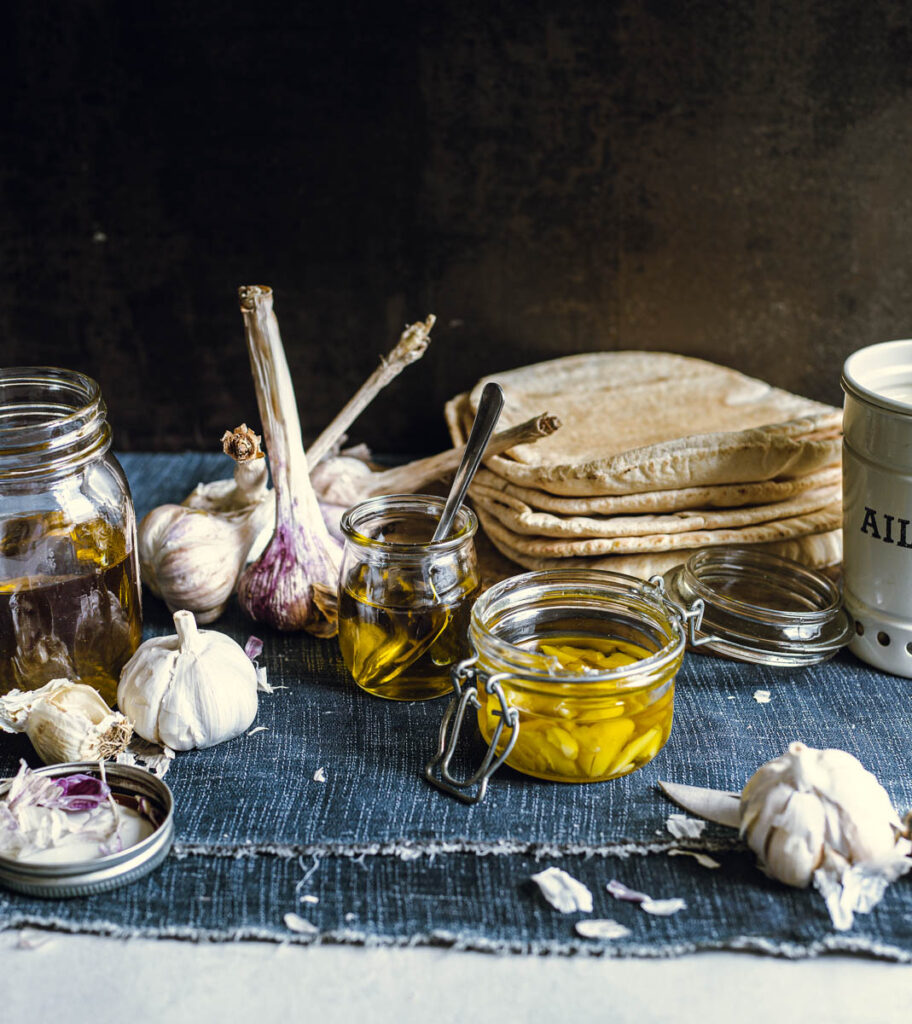
If you try this recipe, I want to know about it! I always appreciate your feedback. Leave a star rating in the recipe card right below and/or a review in the comment section further down the page. You can also follow me on Pinterest, Facebook, or Instagram. Sign up for my email list, too!

Garlic-Infused Oil
Ingredients
- 2 cups extra-virgin olive oil
- 8 cloves garlic fresh, peeled, whole, or halved
Instructions
- Prepare a glass bottle, container, or jar with a tight-fitting lid. Rinse with boiling water and dry thoroughly; put aside.
- Pour the oil into a small saucepan and heat over low heat until just hot to the touch, then remove from the heat. It's important not to overheat the oil, as its flavor and integrity will degrade.
- Add the garlic to the oil, away from the heat, and let stand for about 2 hours.
- Using a fine-mesh strainer, strain into the clean jar, making sure to remove any pieces of garlic.
- Seal jars and store the strained oil in the refrigerator, use within three days or freeze up in icecube trays to three months for safety.
Notes
- Olive oil: Look for a production date, usually November, on the label when buying a bottle to make sure you're buying a recent pressing. Always choose one from the Mediterranean basin produced 100% from olives from the country indicated. Beware of those whose labels simply indicate (usually in small print) "Bottled in ...". This implies that the oil is pressed from olives whose provenance cannot be traced or guaranteed.
- Garlic: Make sure you use a good-looking bulb of fresh garlic—there shouldn't be any green shoots rising upwards. And each pod should be smooth, firm, and not spongy in the slightest. Older garlic is likely to leave an unpleasant bitterness as an aftertaste.
- For a more subtle garlic flavor, leave the cloves whole; for a more potent garlic flavor, cut them in half.
Variant
For a fancy oil, garnish it with herbs or peppers.Nutrition
Get Your Free Plant-Based Eating Toolkit and More
Subscribe to my newsletter and unlock my plant-based course, nutrition charts, recipe secrets, and exclusive updates to prepare wholesome, varied & balanced meals effortlessly. All you need is a good appetite. Subscribe!




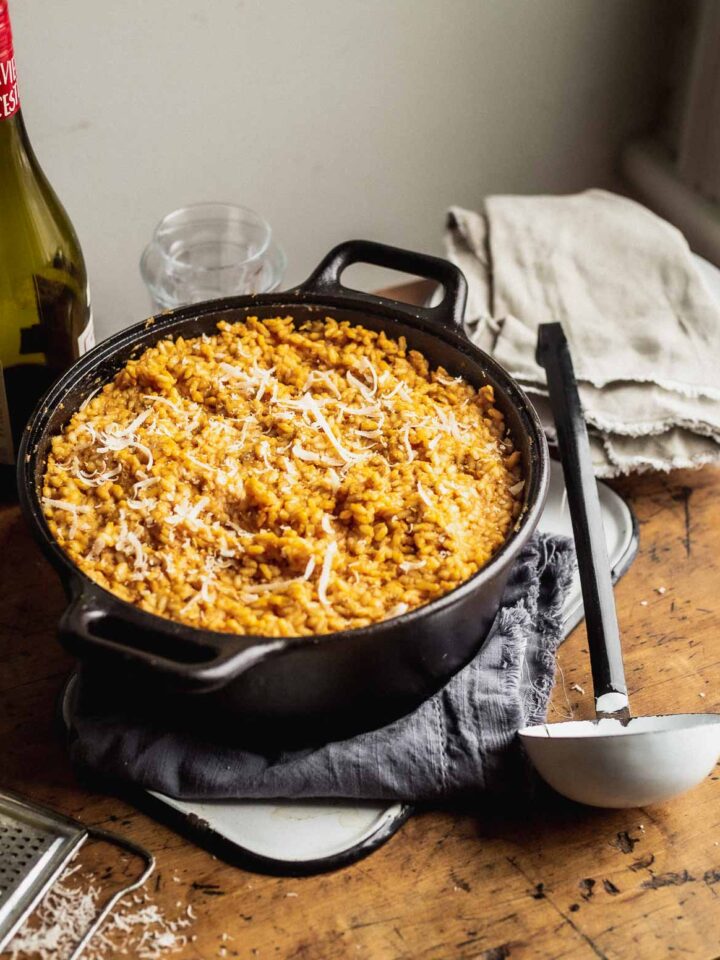


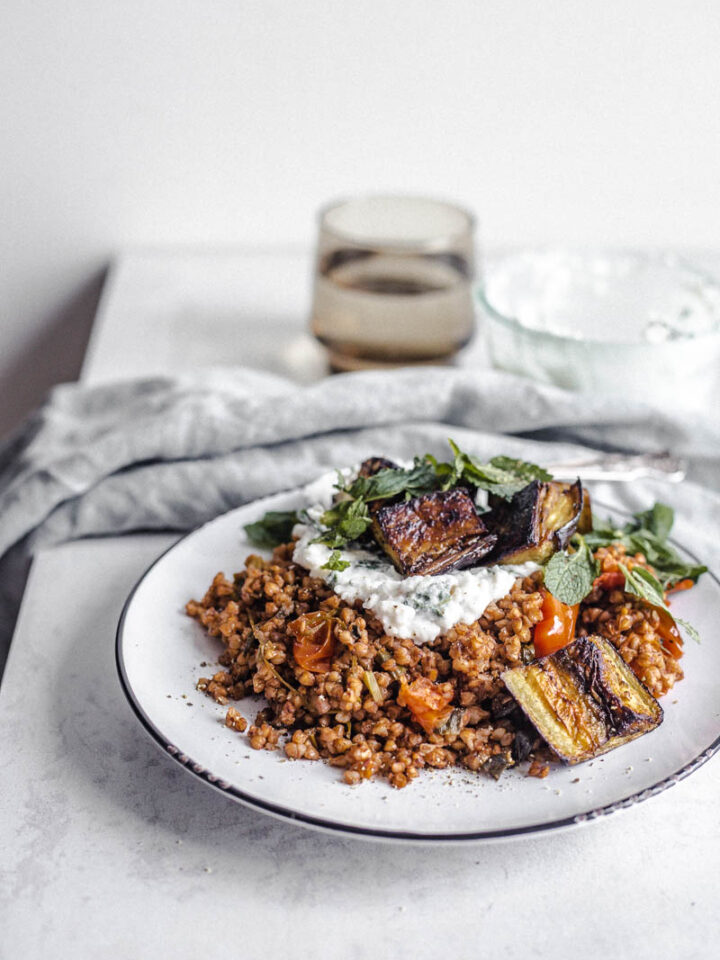
Barry M. says
Naiby; You mention acidifying the garlic/onions above, but say it's rarely ever done at home. I've found a simple method to acidify same (https://extension.psu.edu/how-to-safely-make-infused-oils); however, I'd appreciate your input first. 1) Will the acidifying process leech out evil water-soluble FODMAPs that will then transfer into the olive oil when it's cooked for the infusion? 2) Provided good sanitation, packaging/bottling, and refrigeration is used (including freezing some for long-term use later on), about how long will/should the refrigerator stuff last? 30 days? Longer? 3) I assume that the acidifying won't substantially degrade the taste of the garlic/onion. Your opinion? I appreciate your help. This is all new to me...
Naiby says
Hi Barry. Yes, I also found that article you mentioned. By saying "it's rarely done at home", I meant that hardly anybody actually does it (or so I believe). I did my garlic-infused oil when I posted this article and I still have some in the freezer. So far so good. The taste is still present. I believe you can keep up to two months. I hope it helps. 🙂
Heidy Linn says
Thank you for sharing your story and background reason for sharing these garlic-infused oils. My mother-in-law has serious stomach issues, and I always wonder what triggers them because she is so careful when she cooks---but when they eat out, she has problems, and I am now wondering if it's garlic used at the restaurants that may be the factor. I'm going to pass this blog post link along to her and see what she thinks. Thank you again! You may have just helped us figure out something we never thought of.
Naiby says
Hey, thanks so much Heidy. I have a whole article on the FODMAP diet. Sometimes it's not just garlic. Onions too give the same problem. Anyway, the link is in the first or second paragraph. I hope she checks it out.
FOODHEAL says
Awesome! I am currently having a hard time eating raw garlic. I should try this method and see what's going to happy to my tummy.... Thank you so much for sharing this, it's very helpful
Naiby says
Let me know how it turns out!
amycaseycooks says
This is such a great idea! I’m going to make a batch tomorrow and can’t wait to use the garlicky oil in my cooking.
Mama Maggie's Kitchen says
I love the idea of using garlic-infused oil to my recipes! I will definitely keep this in mind.
Lori | The Kitchen Whisperer says
My best friend now has to follow a fodmap diet and this is PERFECT for her! Thank you so much for sharing such a great recipe!
Naiby says
Yeah! She'll be happy to have this as one of her food staples.
Donna says
There is something so special about the flavours of garlic infused oil, yum! Love how versatile it is.
Sharon says
It is fantastic that you can enjoy this delicious garlic-flavored oil without it bothering those on low-FODMAP diets.
Allyssa says
This is very helpful! Thank you so much for sharing this! will surely use it again!